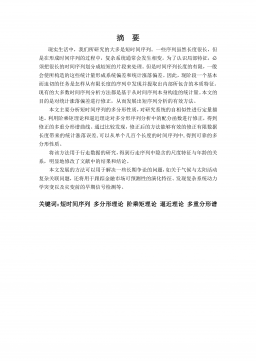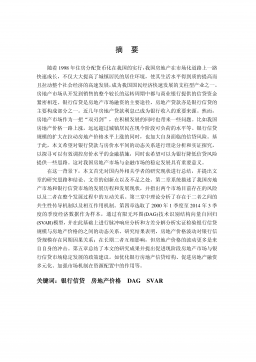绿色校园室外风环境数值模拟研究
VIP免费
摘 要
随着节能环保型社会的推进,绿色建筑已经成为建筑师们备受关注的热点问题。
而高校对于校园建设的要求也越来越高,力求达到绿色校园的标准。文章中通过分析
模拟结果,能够了解校园群体建筑周围风环境,为校园建筑的建设提出可参考意见。
风洞试验和现场实测是建筑风环境的两种主要研究手段,计算流体动力学(CFD)
是近年来风工程研究领域的出现的一种新方法,相较前两者它具有成本小,效率高,
应用广等优点,其与前两者构成了建筑风环境的三大主要研究手段。研究内容如下:
本文以高校建筑为研究对象,采用计算流体力学(CFD)方法,对高校建筑周围
风环境通过计算机模拟的方法进行研究。通过分析研究结果,结合绿色校园标准和风
环境评价标准,对上海理工大学风环境进行了评定,并结合不良的风环境提出了改善
意见。
(1)阅读国内外建筑风环境方向的文献和著作,整体系统地学习前人提出的理
论和研究成果。充分了解该研究方向的国内外现状和研究背景,对风工程以及建筑风
环境的研究成果进行深入研究和总结,学习国内外的研究方法,分析校园建筑室外风
环境的研究现状和研究成果,在前人的基础上提出了本论文的研究方法和研究内容。
(2)详细介绍大气边界层自然风特性、风对结构的作用特点、建筑室外风环境
特点;分析了影响建筑室外风环境的因素,为后续建筑风环境设计做出理论指导。
(3)对计算流体力学 CFD 基本原理进行详细地论述,主要包括 CFD 求解过程
中运用的相关理论依据、湍流模型以及偏微分方程组的离散等等。此外,还对本文应
用到的 FLUENT 软件在湍流模型的选取、计算域及边界条件注意的事项、以及求精
方法和收敛判断做了系统地讨论。
(4)本文运用了 ANSYS FLUNET 14.0 软件,FLUENT 主要是采用多重网格来
加速收敛以便得到更好的收敛速度和求解精度,能够运用不同的求解方法和多重网格
划分的方法加速收敛速度,以便达到更快的收敛速度和更精确的求解精度。并对以上
计算结果采用舒适性指标对建筑的风环境进行分析和评价研究,以其为建筑室外风环
境的优化设计等提供一定的理论依据和指导价值。
(5)选取上海理工大学教学楼、图书馆以及宿舍楼,采用 CFD 进行模拟,分析
上海理工大学室外风环境。
(6)选取上海市两种最常见的主导风向——正东方向和西北方向,分析了不同
来流风向和不同建筑朝向对建筑风环境的影响,并依据《绿色建筑设计标准》评估校
园建筑风环境的舒适性,为校园建筑设计提供可参考的意见。
关键词:绿色校园 计算流体动力学 风环境 数值模拟
ABSTRACT
With the development of energy efficiency and eco-environment society,Green
Building has become the focus of architects. The campus construction is stricter and
stricter to achieve the requirement of Green School. In this paper, the author adopted CFD
to simulate the wind environment in University of Shanghai for Science and Technology.
Through the analysis result, we can know about the campus environment and provide some
reference for the architectural design of green campus.
Wind tunnel experiment and field measurement are the two main building wind
environment research means. Computational fluid dynamics (CFD) is the emergence of a
new method for the wind engineering research in recent years. Compared with the former
two methods, it has advantages of low cost, high efficiency, wide application and so on.
With the first two methods, they are the three main research means of building wind
environment. The research content is as follows:
The research chooses the campus building as the research object, adopt CFD as the
method of numerical simulation, and perform a study on the outdoor wind environment in
colleges and universities. Through the analysis of the study results, according with the
green campus and wind environment evaluation standard, author has evaluated the wind
environment in University of Shanghai Science and Technology and put forward bad wind
environment areas to improve.
(1) Summarize the literature and works at home and abroad in this field, study the
theory and research results in overall range, understand of the research status and research
background at home and abroad in this field, research and summary deeply wind
engineering and building wind environment, learn predecessors' research methods, analyze
research status and research achievements of wind environment in campus and
Universities.
(2) In this paper, the author introduces wind characteristics of the atmospheric
boundary layer, the characteristics of wind environment around the buildings, the
characteristics of the wind load on the surface of buildings. And have analyzed the
influence factors to wind environment to provide some theory reference to architectural
wind environment design.
(3) The basic principle of computational fluid dynamics (CFD) is discussed in detail,
mainly including the related theoretical basis, turbulence model and partial differential
equations of discrete and so on which are applied in the solving process. In addition, in
terms of Fluent, the selection of the turbulence model and computational domain and
boundary conditions matters, as well as the method of refinement and convergence
judgment for this article are discussed systematically.
(4) This paper adopts the ANSYS FLUNET 14.0, which mainly adopts multiple grids
to accelerate convergence in order to get better convergence speed and precision. It can
simulate incompressible fluid to highly complex flow of compressible fluid, and select
many kinds of solving methods and multiple grid accelerating convergence technology to
achieve good convergence speed and precision. Through analysis and evaluation research
on the above calculation results using comfort index of building wind environment, it can
provide optimum design of building outdoor wind environment with certain theoretical
basis and guidance value.
(5) Choosing a teaching building, a library and a dormitory building of University of
Shanghai for science and technology as research subjects, use CFD simulation to simulate
the outdoor wind environment.
(6) Select two of the most common dominant wind direction in Shanghai-East and
northwest, and analyze the effect of different wind flow on building wind environment.
According to the assessment of the green building design standard, provide reference
opinions for campus building design to achieve wind environment comfort in campus.
Key words: Green campus, Computational Fluid Dynamics (CFD), Wind
environment, Numerical Simulation
目 录
中文摘要
ABSTRACT
第一章 绪论 ...................................................................................................................... 1
1.1 前言 ......................................................................................................................... 1
1.2 研究背景及意义 ..................................................................................................... 4
1.2.1 研究背景 .......................................................................................................... 4
1.2.2 研究意义 .......................................................................................................... 5
1.3 国内外风环境研究现状 ......................................................................................... 6
1.3.1 国外研究现状 .................................................................................................. 6
1.3.2 国内研究现状 .................................................................................................. 8
1.4 研究方法及研究内容 ............................................................................................. 8
第二章 建筑风环境 ........................................................................................................ 10
2.1 建筑风环境研究 ................................................................................................... 10
2.2 建筑行人高度风环境舒适性 ............................................................................... 11
2.3 单体与群体的建筑风环境 ................................................................................... 13
2.4 绿色建筑发展的现状 ........................................................................................... 14
2.4.1 国外绿色建筑的发展 .................................................................................... 14
2.4.2 国内绿色建筑的发展 .................................................................................... 16
2.4.3 绿色建筑评价标准 ........................................................................................ 17
2.5 绿色校园的发展 ................................................................................................... 18
第三章 建筑风环境的研究方法 .................................................................................... 21
3.1 CFD 简介 ............................................................................................................... 21
3.2 CFD 求解计算的方法 ........................................................................................... 23
3.2.1 耦合求解法 .................................................................................................... 23
3.2.2 SIMPLE 求解方法 .......................................................................................... 24
3.3 计算流体力学的原理 ........................................................................................... 24
3.3.1 质量守恒方程 ................................................................................................ 25
3.3.2 动量守恒方程 ................................................................................................ 27
3.4 网格划分 ............................................................................................................... 28
3.4.1 非结构化网格 ................................................................................................ 28
3.4.2 面网格划分 .................................................................................................... 28
3.4.3 体网格划分 .................................................................................................... 28
3.5 湍流模型和控制方程 ........................................................................................... 30
3.6 建筑室外风环境的影响因素 ............................................................................... 31
第四章 上海校园建筑风环境模拟分析 ........................................................................ 34
4.1 上海地区的气候特征上海校园建筑风环境模拟分析 ....................................... 34
4.2 划定计算域以及确定边界条件 ........................................................................... 34
4.2.1 边界条件的确定 ............................................................................................ 34
4.2.2 计算域尺寸的确定 ........................................................................................ 37
4.3 低矮建筑单体——综合教学楼模拟工况以及计算结果分析 ........................... 37
4.3.1 综合教学楼概况简介 .................................................................................... 38
4.3.2 EE 正东方向(0°)时综合教学楼风环境分析 ........................................... 39
4.4 高层建筑单体——图书馆模拟工况以及计算结果分析 ................................... 42
4.4.1 图书馆工程概况简介 .................................................................................... 43
4.4.2 EE 正东方向时(0°)图书馆风环境模拟分析 ........................................... 44
4.4.3 NW 西北方向(135°)时图书馆建筑风环境模拟分析 .............................. 47
4.5 低矮建筑群体——上理宿舍区模拟工况以及计算结果分析 ........................... 51
4.5.1 上理宿舍区工程概况简介 ............................................................................ 51
4.5.2 EE 正东方向(0°)宿舍区的风环境分析 ................................................... 52
4.5.3 NW 西北方向(135°)宿舍区的风环境分析 .............................................. 55
第五章 建筑风环境改善措施研究 ................................................................................ 60
5.1 建筑朝向对建筑风环境的影响 ........................................................................... 60
5.2 改变宿舍楼建筑朝向后的风环境模拟分析 ....................................................... 60
5.3 结论与总结 ........................................................................................................... 64
第六章 结论与展望 ........................................................................................................ 65
6.1 本文研究内容总结 ............................................................................................... 65
6.2 进一步的研究内容设想 ....................................................................................... 67
参考文献 .......................................................................................................................... 68
在读期间公开发表的论文及承担科研项目及取得成果 .............................................. 75
致 谢 ................................................................................................................................ 76
第一章 绪 论
1
第一章 绪 论
1.1 前言
随着我国整体生活水平的不断提高,国内已建和待建的高楼大厦拔地而起,越来
越多的人流涌进城市,导致整个城市密度和建筑高度不断增大。而与此同时,随着地
球气候的不断恶化,气候引起的风灾问题也无法令人忽视。根据资料统计,我国每年
的风灾带来的损失也是非常严重。1926 年,钢框架结构的 Meyer-Kisser[1]大楼受到飓
风的袭击,墙体的外围护结构破坏十分严重,本身的钢框架结构也因为飓风的作用发
生塑性变形,变成了一座危楼。2005 年中国因台风带来的直接经济损失大约 233.5
万元,房屋倒塌 30.7 万间,被破坏的农作物面积约 4323.8 万亩,死亡人数约 440 人。
这些风灾事件引发了结构专家们对风工程和风环境的重视[2]。
风作用在建筑物上,会使整个建筑物随之振动,发生以下四种不良结果:
(1)建筑结构构件因受到太大的风作用而不稳定;
(2)反复加载的风作用会使建筑结构发生疲劳损坏;
(3)建筑结构因风荷载的长期的作用而导致外墙围护材料发生破坏;
(4)建筑物因风荷载的作用而产生的轻微震动及摇晃,也会使居住者倍感不适。
根据资料统计结果,1988 年至 2004 年间,每年台风给中国造成的直接经济损失
超过 233.5 亿元,其中倒塌的 30 多万间房屋造成的死亡人数高达 440 人,大面积的
农作物也受到了重创 [3]。风荷载作为建筑的主要侧向荷载,对建筑物的影响的比重还
是很大,尤其是高层建筑和超高层建筑,每年我国都有大量的风灾事件发生[4]。在 1999
年,台风“约克”袭击香港,香港很多标志性建筑物包括湾仔税务大楼等的外围护玻璃
幕墙都受到重创。2003 年,上海大剧院也遭到强风的袭击,屋盖系统表面的材料直
接被强风撕成两半,破坏面积超过 200 平方米。2006 年8月3号,台风“派比安”登
陆深圳,将一排金属广告牌吹倒,砸伤过往行人,可见风灾对于人们危害之大[6]。
现代的城市建筑中,高层建筑,机场港口,体育建筑等挑蓬建筑结构对于风荷载
还是比较敏感的[7],所以建筑风环境成为结构设计中不能不考虑的问题。而建筑风环
境是建筑四大环境(风环境、声环境、热环境、光环境)之一,它是指气流在建筑室
内外的流动情况和流动时对建筑物的影响情况[8]。同时,建筑风环境也是一门交叉学
科,它将建筑学、规划学、流体力学、建筑物理很好地结合在一起[9]。影响建筑风环
境的因素有以下几种:建筑外形、尺寸、间距、布局等等因素。这些影响因素和建筑
设计都是息息相关的,所以在建筑设计中一定要考虑建筑风环境的问题,否则将给建
筑周边甚至整个城市都带来不利的影响[10-11]。城市热岛效应就是因为城市化进程的不
断加快,而导致城市的微气候受到了严重的破坏[12]。城市热岛效应的起因是由城市中
上海理工大学硕士学位论文
2
居民、道路、建筑物等发热体不断发热和蓄热以及城市中植被不断减少等,导致城市
出现“高温化”的现象 [13]。
图1-1 在大风中倒塌的钢结构厂房 图1-2 云南的澜沧江遭遇风灾
即使气候条件一般,风也会给城市容貌和居民生活环境造成影响。尤其是恶劣的
风环境下,人们日常活动的舒适性达不到要求,居民的行动和财产也会受到严重影响
[14]。常见的风环境问题有如下[15]:
(1)街道峡谷效应
随着城市化进程的不断加快,越来越多的高层建筑屹立在街道两旁,城市建筑也
越来越密集,高低错落的建筑群构成一道人工的“街道斜谷”,风汇合在街道里,产生
“峡谷效应”,导致风速突然增大,局部区域出现强风,强风受到建筑物的遮挡,形成
涡流和出现变化气流升降的复杂现象。遇到恶劣的天气时,“峡谷效应”使风的作用更
加明显,恶化了涡流形成和变化气流升降的现象 [16]。
(2)分离涡流
对于高层建筑,更易出现恶劣的风环境。经过高层建筑时,大气边界层的气流会
产生各种频率的分离涡流,这些分离涡流之间存在相互干扰的作用,产生变化频率的
涡流,很有可能引起周围高层建筑物的风致振动。轻微的震动可能会让居民感到不适,
严重时甚至能使高层建筑的结构破坏[17]。
(3)低速漩涡区
高空的气流快速经过高层建筑时会被引导到地面上,碰到建筑的拐角时,气流的
速度突然增大,在拐角的前方停留形成漩涡,导致建筑人行高度处周围的风环境变得
恶劣,给路过行人的生命安全造成威胁。而在建筑密集处,风速在各个建筑群体间无
法畅通,在某些区域形成“空气死角”,使得污染物不能及时扩散,影响到人们的身心
健康。香港淘大花园就是因为建筑密度过高,导致在各高楼之间形成“风闸效应”,加
剧了 SARS 病毒的传播。由此可见,“健康住宅”对于人们的生活至关重要[18]。
第一章 绪 论
3
(4)城市热岛效应
城市热岛效应是城市中居民、道路、建筑等不断发热和蓄热导致城市的温度远远
高于边缘郊区的温度,出现“高温化”的现象。城市热岛效应使城市的热空气上升,遇
到郊区低温后下降,最终热空气在郊区与城市之间环流,带着城市内的污染气体排向
郊区下沉,非常不利于污染气体的排出。同时遇郊区低温下沉的污染气体又会通过地
面运动到城市,导致城市的污染现象更加恶劣 [19]。
(5)城市建筑耗能
恶劣的风环境还会影响到建筑的能耗情况。在炎热的夏季,如果居民住宅的室内
风环境不良,将会阻碍室内外自然通风的顺畅进行,增加空调等制冷系统的负荷[20]。
在寒冷的冬季,不良的风环境又可能增加外墙围护结构的渗透风,导致室内的采暖能
耗不得不增加。因此,一个良好的风环境对于降低建筑能耗是至关重要的[21]。
图1-3 城市风环境 图1-4 城市热岛效应
图1-5 建筑风速云图 图1-6 建筑风压
相关推荐
-
【拔高测试】沪教版数学五年级下册期末总复习(含答案)VIP免费
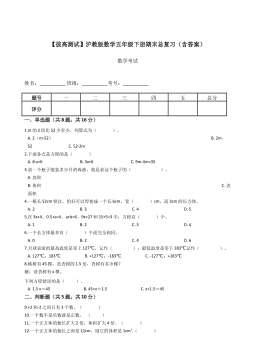
 2024-11-19 19
2024-11-19 19 -
【基础卷】小学数学五年级下册期末小升初试卷四(沪教版,含答案)VIP免费
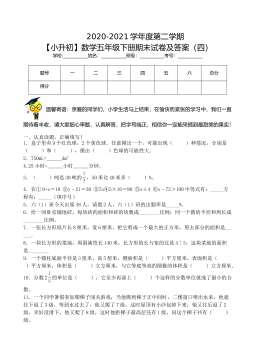
 2024-11-19 9
2024-11-19 9 -
期中测试B卷(试题)-2021-2022学年数学五年级上册沪教版(含答案)VIP免费
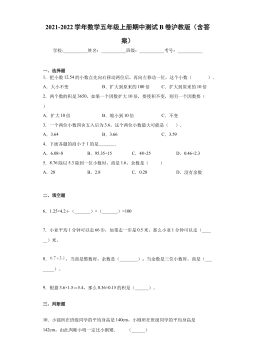
 2024-11-19 11
2024-11-19 11 -
期中测试B卷(试题)- 2021-2022学年数学五年级上册 沪教版(含答案)VIP免费
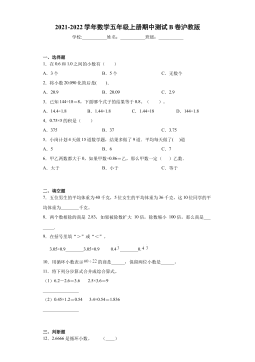
 2024-11-19 16
2024-11-19 16 -
期中测试A卷(试题)-2021-2022学年数学五年级上册沪教版(含答案)VIP免费
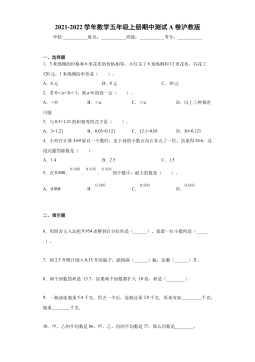
 2024-11-19 18
2024-11-19 18 -
期中测试A卷(试题)-2021-2022学年数学五年级上册 沪教版(含答案)VIP免费
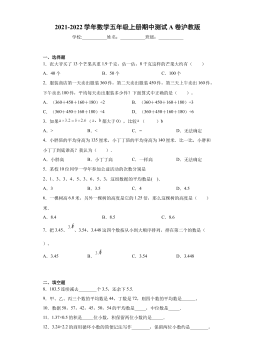
 2024-11-19 25
2024-11-19 25 -
期中测B试卷(试题)-2021-2022学年数学五年级上册 沪教版(含答案)VIP免费
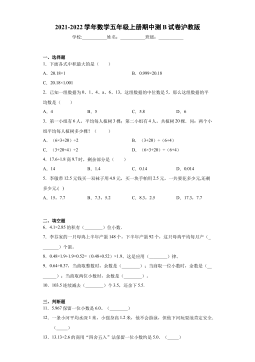
 2024-11-19 23
2024-11-19 23 -
期中测A试卷(试题)-2021-2022学年数学五年级上册沪教版(含答案)VIP免费

 2024-11-19 31
2024-11-19 31 -
【七大类型简便计算狂刷题】四下数学+答案
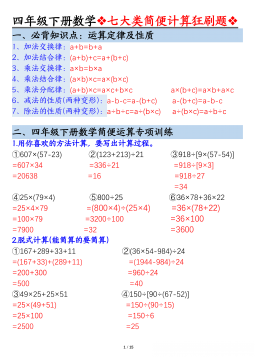
 2025-03-18 16
2025-03-18 16 -
【课内金句仿写每日一练】四下语文
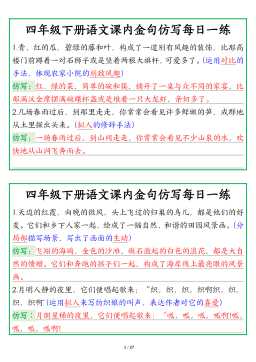
 2025-03-18 39
2025-03-18 39
作者:侯斌
分类:高等教育资料
价格:15积分
属性:79 页
大小:4.49MB
格式:PDF
时间:2025-01-09
相关内容
-

期中测试A卷(试题)-2021-2022学年数学五年级上册 沪教版(含答案)
分类:中小学教育资料
时间:2024-11-19
标签:无
格式:DOCX
价格:5 积分
-

期中测B试卷(试题)-2021-2022学年数学五年级上册 沪教版(含答案)
分类:中小学教育资料
时间:2024-11-19
标签:无
格式:DOCX
价格:5 积分
-

期中测A试卷(试题)-2021-2022学年数学五年级上册沪教版(含答案)
分类:中小学教育资料
时间:2024-11-19
标签:无
格式:DOCX
价格:5 积分
-

【七大类型简便计算狂刷题】四下数学+答案
分类:中小学教育资料
时间:2025-03-18
标签:数学计算;校内数学
格式:PDF
价格:1 积分
-

【课内金句仿写每日一练】四下语文
分类:中小学教育资料
时间:2025-03-18
标签:无
格式:PDF
价格:1 积分


